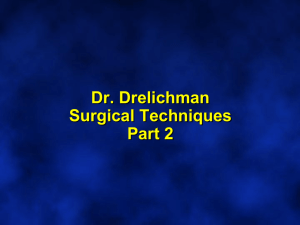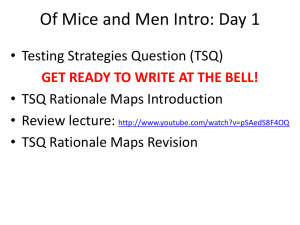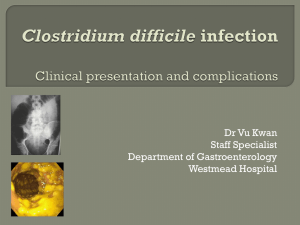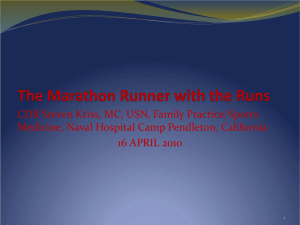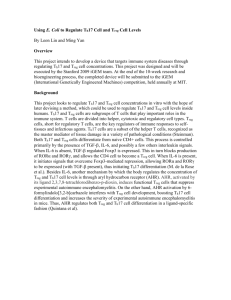Opportunisitic Bacterial Infections in Inflammatory Bowel disease
advertisement
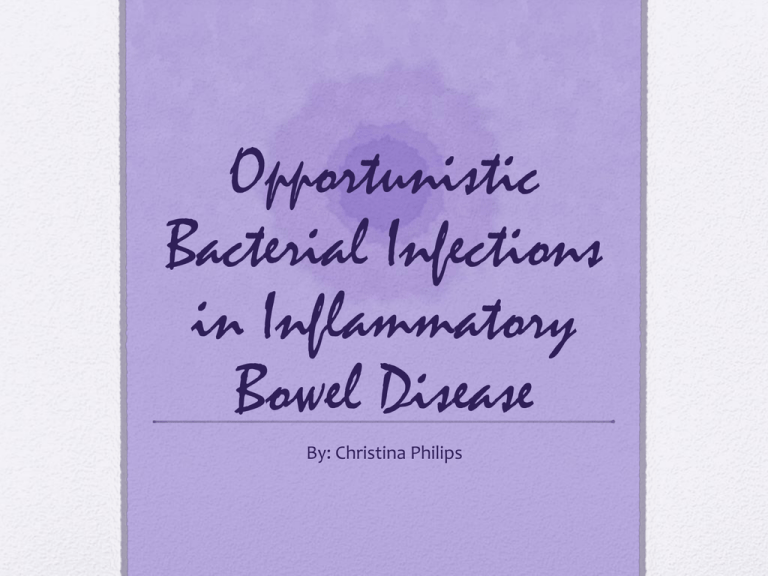
Opportunistic Bacterial Infections in Inflammatory Bowel Disease By: Christina Philips Overview • Background on Opportunistic Bacterial Infections & IBD • Paper #1 • Paper #2 • Specific Aim Background • Opportunistic Bacterial Infections in Inflammatory Bowel Disease can be either non-therapy related or therapy related. • Some infections that occur due to therapies are: • Viruses such as CMV (cytomegalovirus) & HPV (human papillomavirus) • Bacterial infections such as C.difficile • Fungus such as Candida Therapies • Some IBD Therapies: • Immunomodulators such as 6-MP, Imuran, and Methotrexate • Anti-TNF Therapies such as Infliximab and Adalimumab • Risks with Anti-TNF Therapies: • patients stop responding to treatment over time • May develop a bacterial infection How Anti-TNF Therapy Works http://journals.prous.com/journals/dot/20044 004/html/dt400281/images/etan_f05.jpg Paper 1 • Objective: To observe the effects of anti-IL23 mAb on active colitis in a T-cell mediated mouse model. • Model: C3H/HeJBir mouse model (obtained from Jackson Labratories) • This model is highly susceptible to colitis under certain conditions Figure 1 – Cytokine Expression in Colonic Tissue • Researchers tested IL-23 and related cytokines in order to find out the role that these cytokines play in colitis. • SCID mouse models were injected with either the pathogenic CBA – specific Bir14 T cells or the control group (anti-CD3 activated CD 4+ T cells) • In graph A, an increase in these cytokines was seen in the mice injected with the pathogenic Bir14 T cells when compared to the control. • In graph B, both IL-17 & IFNgamma showed increased levels of mRNA expression. Figure 2 – Th17 Cell Detection During Colitis • The T cells were stimulated with PMA & ionomycin after a resting period. The Bir14 T cells showed a higher level of IL-17 rather than IFN-gamma. IL-4 & and IL-10 were not expressed but TNFalpha and IL-6 were expressed. • Mesenteric lymph nodes (MLN) and Lamina propria cells (LPL) from the Bir14 T cells and the control (anti-CD3 T cells) were studied. The IL-17 and IFNgamma production were analyzed via flow cytometry and an increase in these cytokines was seen in the Bir14 T cell but not in the control groups. Figure 3 – Expression of CD 4+ T cell IL-17 response in the presence of IL-23 and IL-12 after stimulation with CBA • As seen from the graph, CD4+ T cell producing IL-17 increases in IL-23 while the production of CD 4+ T cells by IL-12 is inhibited. • The graph the shows the CD4+ T cells production IFN-gamma shows the opposite effect. Figure 4 • In order to test whether the production of IL-23 and IL-12p70 were driven by the CD 4+ T cells, the cytokines were plated in cultures that contained dendritic cell and the pathogenic CD 4+ T cell strain. • The production of IL-23 and IL12p70 was expressed in large amounts in the culture that contained both the Bir14 CD 4+ T cells and the CBA – pulsed BMDCs. This shows that production of these cytokines are dependent on T-cells and antigens. Figure 5 – Th 17 Cells that are Mediators of Colitis • • • • Graph A shows the two different cell lines that were generated after culturinf Bir14 CD4+ T cells with CBA-APC in the presence of IL-23, anti-IL-12, anti-IFN-gamma or IL-12, IFN-gamma, and anti-IL-23. One cell line is a Th17 cell line that produces IL-17 while the other is Th1 cell that produces IFN-gamma. Graph B shows the effects that each cell line has inducing colitis. Only a small amount of Th17 cells were needed to induce colitis whereas a larger amount of Th1 cells was needed to induce colitis. Graph C shows that IL-17 production increased greatly after Th17 cells were transferred. IFN-gamma was barely produced. Graph D is the histopathology between a normal colon, one that has a TH17 cells transferred in, and a colon that has Th1 cells transferred. The Th17 recipient shows more signs of inflammation than Th1 recipient. Figure 6 • Graph A shows that mice that were given the control antibody had colitis but the mice that were given the anti-IL23p19 antibody has little to no effects of the disease. • In graph B, the histopathology between the two antibodies were observed. The control shows more signs of inflammation than the anti-IL-23 antibody. • Graph C shows the expression on genes as analyzed by PCR. This graph shows that gene expression is down regulated in mice that were injected with the anti-IL23p19 antibody. Figure 7 • Graph A shows that mice that had Bir14 CD 4+ T cells transferred and were given the control Abs developed colitis while the group given the anti-IL23 did not. • These three groups were tested for gene expression and the mice given the anti-IL23 Abs had down regulated gene expression. • Figures E and F show the histopathology of the two antibodies. The anti-Il23 antibody shows less effects of colitis. Figure 8 • This graph shows the effects of the blockage of Il-23 and whether it an induce apoptosis of Th17 cells. • The Th17 cells were reduced in the presence of anti-Il23p19 but Th1 cell were not reduced in the presence of anti-Il12p70. Conclusion • Overall, IL-12 stimulates IFN-gamma and Th1 cells while IL-23 effects memory T cells and Th17 cells. • CD4+ Th17 cells is an effector of colitis • Anti-Il23p19 Abs could be used as a therapy to reduce the effects of colitis. Paper 2 • Objective: To investigate the role of the chemokine CXCL10 and its receptor, CXCR 3 in acute colitis. Figure 1 • Graph A shows the mRNA expression of CACL10 and CXCR3 in colonic tissue. The mRNA levels of CXCL10 increased on day 1 and peaked on Day 3. • In B, the CXCL10 is expressed at day 0 and graph C shows that the basal crypt level grew from 1/3 o ½ by day 3 with the addition of DSS. • Non-epithelial cells that produced CXCL10 were seen in the epithelium but not the lamina propria. • Graph D and E shows the expression on CXCL3 in the luminal surface epithelium and a little in the basal crypts. When DSS was added, the CXCL3 cells vanished from the luminal surface but increased in the basal crypts. • F and G were controls Figure 2 • Testing the effects of anti-CXCL10 mAb on DSS induced colitis vs a control mAb. Graph A shows that the mice that were injected with the control experienced weight loss and B shows the decrease in colon length due to the weight loss. The mice that were injected with the anti-CXCL mAb showed well preserved mucosal architecture. • I shows that the blockage of CXCL10 did not effect cell infiltration into the lamina propria. Figure 3 • • • Effect of anti-CXCL10 mAB on Cell traffic to the colon. Slide A-E are with the control Ab while slides B – F are with anti-CXCL10 mAB. A & B are immunostains for CD4 cells, C & D are immunostains for F4/80 and E & F are immunostains for CD11c. The cells that are stained brown are positive cells. Figure 4 • This Graph shows that mucosal infiltration was characterized by apoptotic cells since there weren’t any significant differences in MAsCAM and vicia villosa lectin. The addition of anti-CXCL10 mAbs reduced the number of apoptotic cells. Figure 5 • • • • • • • Effect of Anti-CXCL10 mAb restricted to damage of epithelial cells. 5-Bromo-2’ deoxyuridine (BrdU) is used to label the cells before they are observed. A – Distal colon tissue from mice injected with control mAb B – Distal Colon tissue from mice injected with anti-CXCL10 mAb. BrdU cells are stained in brown. These cells are seen in the bottom 1/3 of crypts in normal colon cells but cells that were exposed to DSS, there is a significant reduction in BrdU cells (A). This shows that the crypt cell growth was impeded. In contrast, B shows that the BrdU+ cells are seen in the replicative zone of the intestinal crypts. Graph C - BrdU+ cells increased in mice that were injected with anti-CXCL10 mAb Figure 6 • Whether CXCL10 directly inhibits reepithelialization or promotes epithelial apoptosis. • Looking at A, mice were pretreated with PBS (vehicle) before injection with BrdU. In B, mice were pretreated with rCXCL10 before injection with BrdU. Graph C shows that there was a significant decrease of BrdU+ cells in the mice that were treated with rCXCL10. • The location of BrdU + cells after 72 hours is seen in D-E. In the control mice (D), these cells disappeared from the epithelium and some were seen in the luminal surface. In the mice treated with rCXCL10, the cells continued to remain in the proliferative zone. • Overall, rCXCL10 inhibits crypt cell proliferation and migration. Conclusions • CXCL10 inhibits crypt cell proliferation and migration. • CXCL10 and the receptor CXCR3 interaction is enhanced in the epithelium in the proliferative zone after DSS induced colitis. • The blockage of CXCL10 increases BrdU+ cells after DSS induced colitis and prevents acute colitis Specific Aim • To determine whether the blocking of chemokines (such as CXCL10) or the development of Anti-Il23p19 Abs therapy would be more effective therapy and decrease the bacterial infections associated with antiTNF therapies.


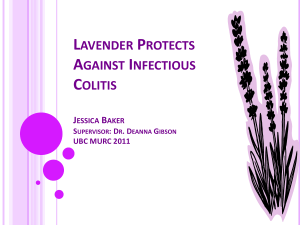
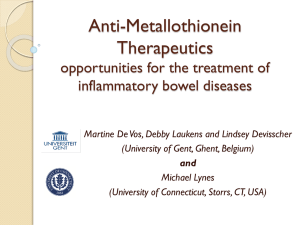
![Historical_politcal_background_(intro)[1]](http://s2.studylib.net/store/data/005222460_1-479b8dcb7799e13bea2e28f4fa4bf82a-300x300.png)

